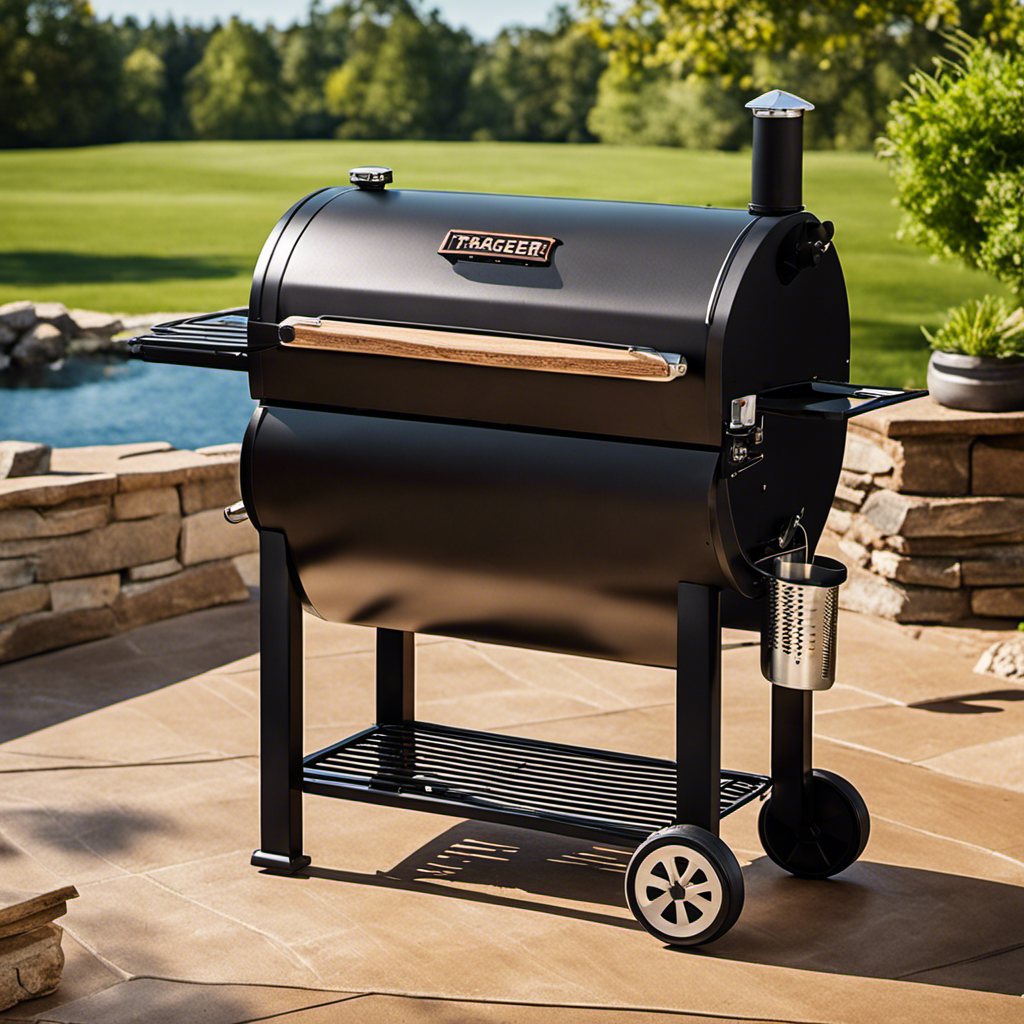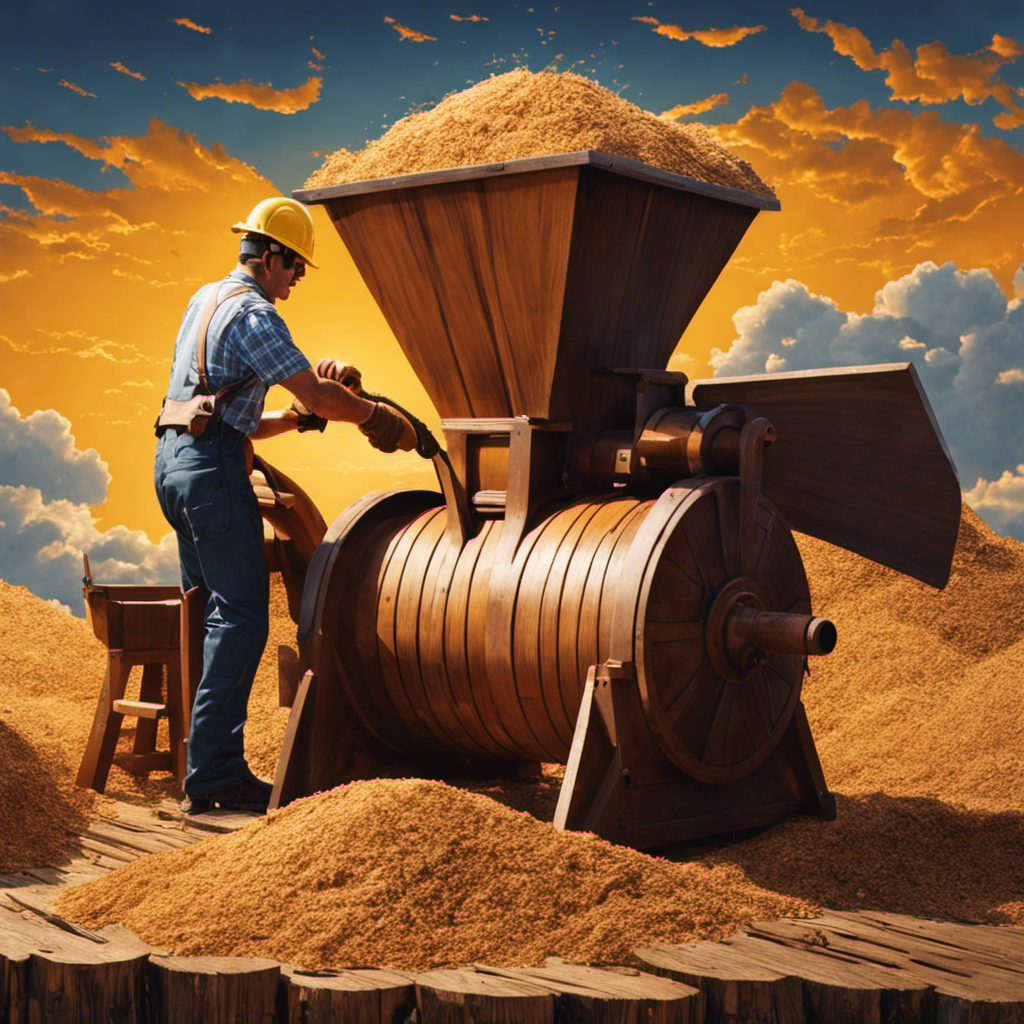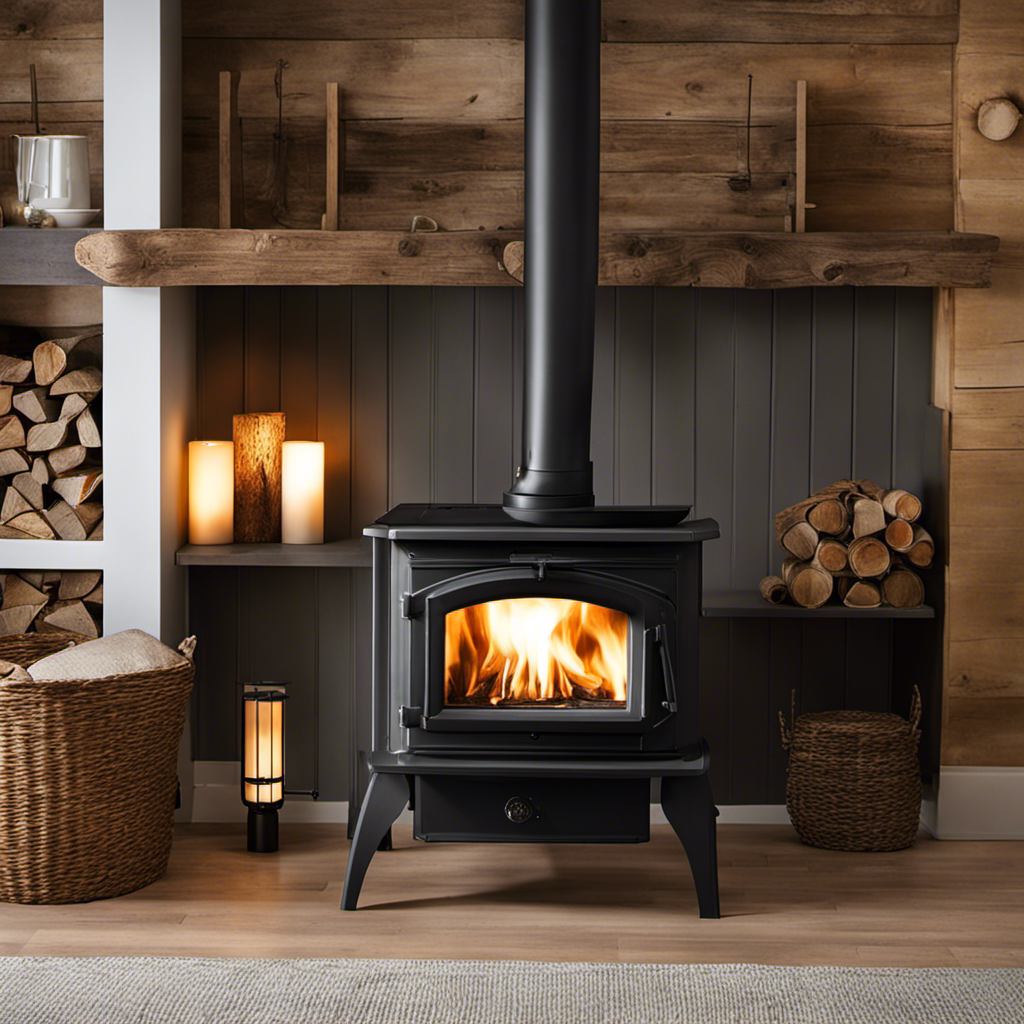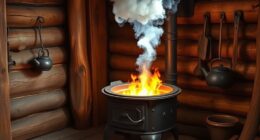The age-old saying, ‘To see is to believe, but to taste is to know the truth,’ holds true in this scenario. Having the opportunity to enjoy the delicious results produced by the Traeger Wood Pellet Grill and Smoker myself has genuinely persuaded me of its outstanding capabilities.
In this article, I’ll guide you through the process of selecting the right wood pellets, preparing the grill, and mastering the art of temperature control.
We’ll also explore cooking techniques and tips, as well as how to add a delightful smoky flavor to your food.
Get ready to elevate your grilling game and become a true pitmaster.
Key Takeaways
- Select wood pellets based on your desired flavor profile
- Prioritize cleaning and maintenance for optimal grill functioning
- Learn temperature control tips for better grilling experience
- Season the grill to create a nonstick surface and enhance flavor
Selecting the Right Wood Pellets
When selecting the right wood pellets for your Traeger grill, it’s important to consider the flavor profile you want to achieve. Choosing the right pellets can greatly enhance the taste of your food.
Traeger offers a wide variety of wood pellets, each with its own unique flavor. Whether you prefer a mild, smoky taste or a more robust and bold flavor, there is a pellet to suit your preference. Additionally, Traeger also provides alternative fuel options, such as fruitwood pellets, which can add a subtle sweetness to your dishes.
By selecting the right pellets, you can elevate the flavor of your grilled and smoked meats, vegetables, and even desserts.
Now that you know how to choose the perfect wood pellets, let’s move on to preparing the grill and smoker for an amazing cooking experience.
Preparing the Grill and Smoker
When it comes to preparing my grill and smoker, there are a few key points I always keep in mind.
First and foremost is the importance of cleaning and maintenance. Regularly cleaning the grill not only ensures that it functions properly, but also helps to extend its lifespan.
In addition, I’ve learned some valuable temperature control tips that have greatly improved my grilling experience.
Finally, one essential step in preparing the grill is seasoning it. This process helps to create a nonstick surface and enhances the flavor of the food.
Cleaning and Maintenance
To keep your Traeger wood pellet grill and smoker in top condition, make sure you regularly clean and maintain it. Here are some cleaning tools and deep cleaning techniques that I find effective:
- Grill brush: Use a sturdy grill brush to remove food residue and grease from the grates.
- Ash vacuum: To clean the ash from the firepot and bottom of the grill, an ash vacuum is perfect.
- Degreaser: A good degreaser helps remove tough grease and grime from the interior and exterior surfaces.
- Aluminum foil: Line the drip tray with aluminum foil to catch grease and make cleanup easier.
- Scraper tool: Use a scraper tool to remove stubborn residue from the grates.
By regularly cleaning your Traeger grill and smoker using these tools and techniques, you can ensure it functions at its best and prolong its lifespan.
Now, let’s move on to some temperature control tips for optimal cooking results.
Temperature Control Tips
For optimal cooking results, it’s important to monitor and adjust the temperature on your Traeger. Proper temperature control techniques are essential to ensure that your food is cooked thoroughly and evenly. To help you troubleshoot temperature fluctuations, here are some tips:
| Temperature Control Tips | Troubleshooting Temperature Fluctuations |
|---|---|
| Preheat your grill for 10-15 minutes | Check for air leaks around the door and hopper |
| Use the Traeger app or controller to set the desired temperature | Clean the fire pot and remove any debris |
| Avoid opening the lid frequently | Check the auger for any jams or blockages |
| Consider using a temperature probe | Adjust the P-setting for better temperature control |
Seasoning the Grill
Once you’ve completed the temperature control techniques, it’s time to season your grill for its first use. Properly seasoning your grill is essential for maintaining its performance and ensuring delicious results. Here are five important seasoning techniques for grill maintenance:
- Clean the grill grates thoroughly with a wire brush to remove any manufacturing residue or debris.
- Apply a thin layer of cooking oil to the grates to prevent food from sticking and promote even heat distribution.
- Preheat the grill to a high temperature for about 15 minutes to burn off any remaining oils or contaminants.
- Allow the grill to cool down, then wipe the grates with a clean cloth to remove any excess oil.
- Repeat the seasoning process before each use to maintain the grill’s non-stick surface and enhance the flavor of your food.
Now that your grill is properly seasoned, let’s move on to igniting and preheating the grill for optimal cooking.
Igniting and Preheating the Grill
When it comes to lighting the grill, there are a few different options to consider.
One popular method is using a chimney starter, which allows for quick and efficient ignition of the charcoal.
Another option is using lighter fluid, although this can sometimes leave a residual taste on the food.
Once the grill is lit, it’s important to have temperature control options in place, such as adjustable vents or a built-in thermometer, to ensure that you can achieve the desired heat for your cooking.
Lighting the Grill
To light the grill, simply press the ignite button and wait for the pellets to start burning. It’s important to keep your grill well-maintained for optimal performance.
Here are some grill maintenance and troubleshooting tips:
- Clean the grill grates regularly to prevent buildup and ensure even cooking.
- Check the hopper for any pellet blockages or debris that could affect the flow of pellets.
- Keep an eye on the temperature gauge to ensure it reads accurately.
- If the grill is not heating up properly, check the fire pot for any ash buildup that may be blocking the burn pot.
- Make sure the grill is placed on a stable and level surface to prevent any accidents.
Now that you know how to light the grill and some maintenance tips, let’s move on to the temperature control options for precise cooking.
Temperature Control Options
You can easily adjust the temperature on your grill by using the control panel and selecting your desired cooking temperature. The temperature control accuracy of a Traeger wood pellet grill is one of its key features.
The control panel allows you to set the temperature in precise increments, ensuring that your food cooks to perfection every time. However, if you experience temperature fluctuations, there are troubleshooting steps you can take to resolve the issue.
Check for any obstructions in the pellet hopper or auger tube, as these can affect the flow of pellets and thus the temperature. Additionally, make sure the grill is properly cleaned and maintained to ensure optimal performance.
Understanding the temperature control is crucial for achieving consistent and delicious results.
Understanding the Temperature Control
Understanding the temperature control on the Traeger wood pellet grill and smoker is crucial for achieving the desired cooking results. Here are some key things to know:
-
Temperature Control Troubleshooting: If you’re having trouble maintaining the temperature, check the pellet hopper for any blockages or low fuel levels. Also, make sure the grill is properly sealed to prevent heat loss.
-
Understanding Heat Zones: Traeger grills have different heat zones, allowing you to cook different foods at the same time. The lower grate is cooler, perfect for slow cooking, while the upper grate is hotter, ideal for searing.
-
Dialing in the Temperature: Use the digital control panel to set your desired temperature. The grill’s internal thermostat will regulate the heat automatically, ensuring consistent cooking.
-
Monitoring the Temperature: Keep an eye on the temperature gauge to ensure it stays within your desired range. Adjust the temperature setting as needed for precise cooking.
-
Preparing and Seasoning the Food: Now that you understand temperature control, it’s time to prepare and season your food for delicious results.
Preparing and Seasoning the Food
Now that you’ve learned about temperature control, it’s time to focus on the next step: preparing and seasoning your food for a delectable meal.
When it comes to grilling on a Traeger wood pellet grill and smoker, marinating techniques and the right grilling accessories can take your dishes to the next level. To enhance the flavor of your food, try marinating it overnight using a mixture of your favorite herbs, spices, and liquids. This will help tenderize the meat and infuse it with delicious flavors.
Additionally, investing in grilling accessories like a meat thermometer, grill brush, and grill baskets can make your grilling experience more convenient and enjoyable. These tools ensure that your food is cooked to perfection and make cleanup a breeze.
With these marinating techniques and grilling accessories, you’ll be ready to create mouthwatering dishes on your Traeger wood pellet grill and smoker.
In the next section, we’ll explore cooking techniques and tips to help you become a grill master.
Cooking Techniques and Tips
To elevate your cooking skills, try experimenting with different cooking techniques and incorporating helpful tips into your culinary repertoire. Here are some cooking techniques and recipe ideas to inspire you:
-
Grilling: Perfect for cooking meats, vegetables, and even fruits, grilling imparts a smoky flavor and beautiful grill marks.
-
Roasting: This method is great for larger cuts of meat or whole poultry. It results in juicy and tender dishes with a crispy exterior.
-
Smoking: Use your Traeger wood pellet grill and smoker to infuse your food with a delicious smoky flavor. Try smoking ribs, brisket, or even cheese.
-
Searing: Achieve a caramelized crust on your steaks or seafood by searing them over high heat. It adds depth of flavor and a mouthwatering texture.
-
Baking: Don’t limit your Traeger to just grilling. You can also bake bread, pizzas, and desserts, giving them a unique wood-fired taste.
By incorporating these cooking techniques and recipe ideas, you’ll be able to create a wide variety of delicious dishes.
Now, let’s move on to monitoring and maintaining temperature to ensure perfect results every time.
Monitoring and Maintaining Temperature
By keeping an eye on the temperature, you can ensure that your dishes turn out perfectly cooked every time. Monitoring and maintaining the temperature is crucial when using a Traeger wood pellet grill and smoker. The table below shows the recommended temperature range for different types of dishes:
| Dish | Temperature Range |
|---|---|
| Steaks | 450°F – 500°F |
| Poultry | 275°F – 325°F |
| Vegetables | 350°F – 400°F |
To achieve the desired temperature, preheat the grill and use the temperature control dial to adjust accordingly. It is important to monitor the temperature throughout the cooking process and make adjustments as needed. This ensures that your food cooks evenly and avoids overcooking or undercooking. Maintaining a consistent temperature is key for delicious results. Now that you know how to monitor and maintain temperature, let’s move on to adding flavor with wood smoke.
Adding Flavor With Wood Smoke
When adding flavor to your dishes, don’t forget to incorporate the smoky goodness of wood smoke. It can elevate your food to a whole new level. Here are some ways to enhance your food with smoke flavor variations:
- Experiment with different types of wood chips, like mesquite, hickory, apple, or cherry, to create unique flavors.
- Soak your wood chips in water or another liquid, like beer or apple juice, before using them to infuse even more flavor.
- Use a smoking box or foil pouch to contain the wood chips and prevent them from burning too quickly.
- Adjust the amount of smoke by controlling the air intake and the temperature of your grill or smoker.
- Consider adding herbs, spices, or marinades to your food before smoking to enhance the overall flavor profile.
Now that you know how to add smoky goodness to your dishes, let’s move on to some cleaning and maintenance tips to keep your Traeger wood pellet grill and smoker in top shape.
Cleaning and Maintenance Tips
Once you’ve finished grilling, it’s important to clean and maintain your wood pellet grill and smoker so it stays in top shape. Proper grill maintenance not only ensures that your grill will last longer, but it also helps to prevent any potential health hazards. Here are some cleaning tips to keep your wood pellet grill and smoker in great condition:
| Cleaning Task | Frequency | Tips and Tricks |
|---|---|---|
| Emptying Ashes | After each use | Use a shop vac or ash vacuum for easy cleanup. |
| Cleaning Grates | After each use | Scrub the grates with a grill brush to remove residue. |
| Exterior Cleaning | Monthly | Wipe down the exterior with warm, soapy water and a soft cloth. |
Can the same techniques be used to operate both the Traeger Wood Pellet Grill and the Pit Boss Wood Pellet Grill?
Yes, the same techniques can be used to operate both the Traeger Wood Pellet Grill and the Pit Boss Wood Pellet Grill. Both grills are designed to function in a similar manner, making it easy for users to switch between the two without much difficulty. With some reser pir boss grill understanding, you can effortlessly operate both grills.
Frequently Asked Questions
How Long Does It Take for the Traeger Wood Pellet Grill and Smoker to Reach the Desired Temperature?
It usually takes about 10-15 minutes for my Traeger wood pellet grill and smoker to reach the desired temperature. The time may vary depending on the type of wood pellets used.
Can I Use Any Type of Wood Pellets in the Traeger Grill and Smoker?
Yes, you can use alternative types of wood pellets in the Traeger grill. However, it’s important to choose the right ones to enhance the flavor of your food. Different wood pellets offer unique tastes, adding depth and richness to your dishes.
How Often Should I Clean the Grill Grates and Other Parts of the Grill?
I clean the grill grates and other parts of the grill regularly to ensure proper maintenance. Following a cleaning schedule helps maintain the grill’s performance and prolong its lifespan.
Can I Use the Traeger Grill and Smoker in Cold Weather?
Yes, you can use the Traeger grill and smoker in cold weather. However, it’s important to properly maintain it by regularly cleaning the grill grates and other parts to ensure optimal performance. Additionally, here are some tips for smoking meat in cold weather.
How Do I Prevent Flare-Ups While Cooking on the Traeger Grill and Smoker?
To prevent flare-ups while cooking on the Traeger grill, I control the temperature by adjusting the settings and using the proper amount of wood pellets. This ensures even heat distribution and reduces the chances of flare-ups.
Conclusion
In conclusion, using the Traeger wood pellet grill and smoker is an absolute game-changer. It takes your outdoor cooking experience to a whole new level of deliciousness and convenience.
From selecting the perfect wood pellets to achieving the ideal temperature control, this grill has got it all covered. With its easy-to-use features and mouthwatering results, you’ll be the envy of all your neighbors.
So get ready to elevate your grilling game and become a master chef in your own backyard. It’s time to unleash the flavor and create unforgettable meals with the Traeger wood pellet grill and smoker.
Growing up surrounded by the vast beauty of nature, Sierra was always drawn to the call of the wild. While others sought the comfort of the familiar, she ventured out, embracing the unpredictable and finding stories in the heartbeat of nature.
At the epicenter of every remarkable venture lies a dynamic team—a fusion of diverse talents, visions, and passions. The essence of Best Small Wood Stoves is crafted and refined by such a trio: Sierra, Logan, and Terra. Their collective expertise has transformed the platform into a leading authority on small wood stoves, radiating warmth and knowledge in equal measure.











